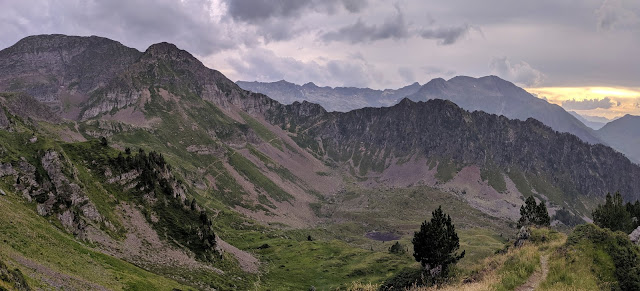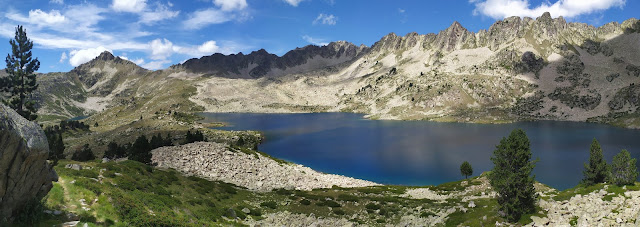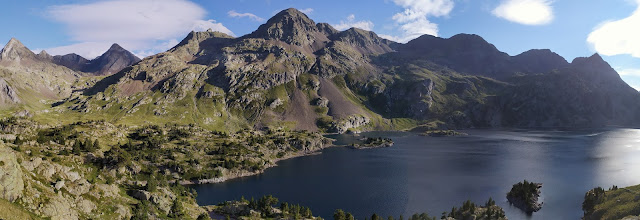Trans Pyrenees Hike (800 km/20 days)
To cross from the Mediterranean Sea to the Atlantic through the Pyrenees has long been a goal. The fact that you're crossing an entire continent via mountains is already inspiring... Moreover, the route's length is about 800 kilometers, which is an optimal distance for a 20-day fast hike...
There are three main Pyrenean routes that stretch from the Atlantic Ocean to the Mediterranean Sea... The most famous one passes on the French side and is called the GR10. It starts from the town of Hendaye, near the ocean, and ends in the Mediterranean town of Banyuls-sur-Mer. A less well-known but also very picturesque and well-marked route, the GR11, passes through Spain. The most challenging and toughest route is the HRP, which goes through the highest Pyrenean mountains across Spain, France, and the small country of Andorra. This route is almost unmarked, and you need to navigate using maps and GPS...
Of course, the HRP was chosen as the base for the trek, which, like the GR10, has the same starting and ending points - the towns of Hendaye and Banyuls-sur-Mer, respectively. The goal was to go in the reverse direction, increasing the priority of water bodies - from the sea to the ocean, i.e., from Banyuls to Hendaye...
Dates: 29.07-16.08.2019
Dates: 29.07-16.08.2019
Interactive map of the route:
Getting there: I flew with the low-cost airline Ryanair from Kaunas to Girona, and from there took buses to the start in the town of Banyuls-sur-Mer... From Girona airport (as well as from Barcelona), the cheapest way is to take the Flixbus (better to buy a ticket in advance on the company’s website) to the town of Perpignan, and then transfer to local bus No. 400 to Banyuls-sur-Mer (departure from platform 15 at the same bus station where Flixbus arrives, pay the driver, one euro). The bus trip took me about 3 hours in total.
After finishing the route in the French town of Hendaye and spending two days by the ocean, I moved to the neighboring Spanish city of Irun, from where I took a direct bus to Barcelona. The cheapest carrier was Monbus (better to buy a ticket in advance on the company’s website).
We are at the start...
During the entire journey through the Pyrenees, I stayed once in a refuge (16 euros) and once in an albergue in the Spanish village of Isaba (14 euros), due to bad weather and the lack of cabins and shelters nearby, as I was traveling without a tent. Most nights I spent under the starry sky on a foil mat with a down sleeping bag and a Tyvek bivy bag. A few times I stayed in free cabins, and once a small rain at night saved me by using a tourist shelter (that's what poorly adapted for overnight stay shelters are called on the map)…
We are at the start...
During the entire journey through the Pyrenees, I stayed once in a refuge (16 euros) and once in an albergue in the Spanish village of Isaba (14 euros), due to bad weather and the lack of cabins and shelters nearby, as I was traveling without a tent. Most nights I spent under the starry sky on a foil mat with a down sleeping bag and a Tyvek bivy bag. A few times I stayed in free cabins, and once a small rain at night saved me by using a tourist shelter (that's what poorly adapted for overnight stay shelters are called on the map)…
Lifehack… The Mapy.cz app was extremely useful for navigation and planning each night’s stay (it’s much better than all others tested before and conserves battery power). Before the trip, I downloaded offline maps of the entire Pyrenees region in this app, which included the routes of the GR10, GR11, HRP, and the current locations of refuges, cabins, shelters, and springs...
For your information, an overnight stay in high-altitude refuges costs about 20 euros (2019 year), and it is usually necessary to take dinner and breakfast, which can total 40-50 euros... A good alternative is free cabins, but you can't rely on them too much; some may be closed or in poor condition (no bunks, only concrete floors), or even occupied by shepherds... Once I arrived at a planned cabin by a lake at over 2200 meters after sunset, but it was occupied by a man and a woman grazing horses in the valley. The weather was getting worse, the sky was heavily clouded, and I didn't want to sleep outside. I talked to the man, and he told me there was a good cabin over the next mountain where I could stay. I checked the map and found it, but I had to climb another mountain off the route to reach it... There was no visible path on the map, it was already dark, and I had no flashlight... But for a warm night’s sleep, I literally ran to the cabin and didn't regret it. By morning, it was raining and very foggy...
One of the coolest cabins I stayed in...
I went on the trip with my good friend and project partner from "The Running Pilgrims" - Dima Zhmil. For the first eight days, we walked together along the HRP route...
It was interesting to walk past a forest of half-naked cork oak trees, from whose bark cork is made...
We crossed the entire length of Andorra in a day...
On the eighth day, we split, and I switched to the GR10 route... Since the first aid kit, flashlight, stove, "Bond" fuel, and tent were shared, I continued without these items... I missed only the flashlight and antiseptic the most... I didn’t need the stove at all, as I switched to food that didn’t require cooking. And the absence of a tent only motivated me to better plan my nights to be near shelters in bad weather...
Attention! Another important point to note... There are many ticks on the route; I pulled out about seven in the first 350 kilometers from Banyuls-sur-Mer...
During my solo trek, I mixed all three routes - HRP, GR10, and GR11... In a window of good weather and visibility, I switched back to the HRP from the GR10...
Someone picked a nice spot for their tent...
Then the weather worsened, and I decided to descend to the Spanish side of the GR11 route... This is the essence of free passage... When thanks to modern technologies and skills in orientation and map usage with GPS, you can adapt the route to yourself, not the other way around... After all, in the mountains, you can never plan everything in advance...
Walking through a foggy valley among many young calves and horses, while heading down to a gorge, a young guy, about 23 years old, stopped by me in a small jeep and offered a ride... I realized he worked with the livestock, so I decided to ask about his job, as I often encountered cattle pastures along the way... He told me he raises calves for sale, selling 5-6 month-old male calves for 800 euros and females for 600, as they have less meat and more fat... Grazing in the mountains lasts about 8-9 months a year on different slopes... He loves his job and is happy with the good earnings, planning to expand his herd for greater reproduction... He takes the cows to the valley for the season, where they graze on their own with bells and ear tags, and then they reproduce...
By the way, all pasture exits are fenced with barbed wire or low-voltage wire. There are many pastures along the route, and I hardly saw any shepherds...
Reaching the intersection of the GR11 and the mountainous part of the pilgrim's route - Camino de Santiago, I once again crossed the Pyrenees and reached the iconic town of Saint-Jean-Pied-de-Port...
A pilgrim walks his Camino... When you are alone, the true pilgrim's path you walk is within yourself...
The town of Saint-Jean-Pied-de-Port... Here the Camino begins for most pilgrims, and the concentration of inspiring energy is off the charts... Most people start their over 800 km journey here, and for many, this Camino trek is the challenge of a lifetime... For some reason, it was here that I felt like lighting my candle...
I had the idea to enrich my journey not only with mountains and mountain landscapes but also with other elements... To once again immerse myself in the magical atmosphere of pilgrims on the Camino, visit the colorful mountain villages of Spain and France, enter ancient temples, and feel the spirit of both natural and man-made wonders. The main goal was not to be tied to a specific route and rush to complete it at any cost... The key was not to lose the sense of joy in the moment and the feeling of complete freedom...
From Saint-Jean-Pied-de-Port, I continued along the GR10 and reached the ocean in the resort town of Hendaye in two and a half days. I finished my route on the nineteenth day, averaging 40 kilometers per day...
Food on the trek: The main practical experience from the trip was a complete transition to food without cooking, using products available in supermarkets along the route - couscous, wheat porridge, oatmeal, Thai noodles, raisins, dates, nuts, a mix of nuts and dried fruits. The general principle of eating was that all porridges were soaked in cold water and infused for different periods, so meals had to be planned accordingly. Porridges that cook in 5 minutes are ready in about 4 hours of soaking, oatmeal and Thai noodles (like "instant noodles" but without chemicals and much more expensive) take 30 minutes.
Food format:
1) Breakfast... Porridge soaked in a mold from the evening (usually the one that takes the longest to cook) with 125 g of porridge + 50 g of raisins or dates (if it's hard to find raisins or dates, sugar can be used, it's very hard without glucose). The first meal is two hours after the start, allowing for a quick pack-up, warming up on the route, and having breakfast in a scenic spot with half the portion, eating the next part three hours later, and soaking the next portion of another porridge with the same calculation.
2) During the day, you can soak oatmeal, which cooks quickly, or wheat porridge (French barley), which takes 3 hours. For snacks, the best options for me were 150 grams of nuts with dried fruits, or 150 grams of dates with peanuts, or just 150 grams of peanuts per day. In extreme cases, cookies, about 200 grams per day.
3) In the evening, I soaked Thai noodles - 80 grams, added grated cheese, ketchup, sometimes canned lentils.
4) As a bonus, during each visit to a supermarket, I would get milk with pastries.
4) As a bonus, during each visit to a supermarket, I would get milk with pastries.
Lifehack... A 500-gram pack of porridge is divided into four portions (yielding 125 grams per portion, packaged immediately in bags for compactness). Anything that cooks in up to 5 minutes is suitable. Dry cereals are the worst option, providing the least satiety. If you stick exclusively to the GR10 or GR11 routes, with an average pace of 40 km per day, you encounter markets at least once a day, so you can carry minimal food. You can take canned beans (lentils, chickpeas), transfer them to a foil bag, and have a good addition to porridge or noodles.
An example of a 4-day market purchase in France:
- Pack of couscous (semi-cooked, absorbs water very well) - 500 grams
- Pack of oatmeal or wheat porridge (like barley, the best option) - 500 grams
- Pack of Thai noodles - 250 grams
- Grated cheese - 250 grams
- Ketchup in a plastic bottle - 300 grams
- Raisins - 400 grams
- Mixed nuts or just peanuts - 600 grams. Total: 2800 grams (700 grams per day)
Equipment:
- Backpack Travel Extreme 28 - 710 grams
- Mat (foil-covered) - 95 grams
- Bivy bag (Tyvek) - 200 grams
- Sleeping bag - 475 grams
- Pot 1.8 liters - 266 grams
- Thermal underwear (top) - 135 grams
- Thermal underwear (bottom) - 116 grams
- Fleece - 230 grams
- Cap - 100 grams
- Warm socks for sleeping - 45 grams
- Spare socks for trekking (three pairs) - 60 grams
- Container with lid (500 ml) - 56 grams
- Wooden spoon (sturdy and light) - 10 grams
- PET bottle 750 ml - 30 grams
- PET bottle 500 ml - 25 grams
- Toothpaste - 80 grams
- Toothbrush - 10 grams
- Comb - 20 grams
- Roll-on deodorant - 60 grams
- Ultralight jacket - 150 grams
- Phone Xiaomi Redmi Note 7 - 200 grams
- Charger with cable - 100 grams
Important! I took a charger with three ports, one of which supports fast charging for my smartphone, and the other ports in case of limited outlets at charging spots. Most often, I charged my phone in tourist offices, which also offer free Wi-Fi. Almost every town along the GR10 and GR11 routes has tourist offices, marked on the Mapy.cz app. In a tourist office, you can leave your phone with the manager for charging and explore the town. All for free.
Tourist office in the town of Gavarnie...
What I wore:
- Altra Lone Peak 3.0 NeoShell Low sneakers
- Altra gaiters (keeps socks and shoes clean from the inside)
- Shorts (advantages: no need for underwear, quick drying, easy to wash and wear, comfortable)
- Compression leggings
- Tank top
- Arm warmers (easy to put on and take off if it's cool)
- Two buffs



































































































Круто, як завжди)
ReplyDeleteДякую, дуже крутий звіт, давно цікавлюсь цим маршрутом. Маю технічне питання - в звіті купа крутезних фоток, і як я розумію, вони зроблені на телефон з переліку спорядження. Чи застосовували Ви для них якусь пост-обробку, чи він сам так фотографує?
ReplyDeleteВечірні кадри фотографую через додадок Google камера... Панорами клею вдома в програмі panorama maker... Використовую hdr, коли багато тіні... Ось і все...
DeleteВи зробили справді дивовижні речі!
ReplyDelete